Home » Gemstones » Ruby and Sapphire
Ruby and Sapphire
Red corundums are rubies. Blue corundums are sapphires. Trace elements produce their colors.
Author: Hobart M. King, PhD, GIA Graduate Gemologist

Rubies: The most desired variety of corundum is the ruby. The red color is produced by trace amounts of chromium in the mineral. These two beautiful rubies were mined in Madagascar. The one on the left is a 7 x 5 millimeter octagon that weighs about 1.32 carats. The one on the right is an 8 x 6 millimeter oval that weighs about 1.34 carats. Although Asia has been the traditional source of gem corundum for over one thousand years, Africa is poised to become a new primary source.
Ruby, Sapphire, and Fancy Sapphire
Most people don't realize that ruby and sapphire are both gems of the mineral corundum. Both of these gemstones have the same chemical composition and the same mineral structure. Trace amounts of impurities determine if a gem corundum will be a brilliant red ruby or a beautiful blue sapphire. It is surprising that "impurities" can produce such wonderful results!
Red and blue are just two of the many colors found in gem corundums. Trace amounts of other elements can produce brilliant yellow, orange, green, and purple gems. Red corundums are known as "rubies," blue corundums are known as "sapphires," and corundums of any other color are known as "fancy sapphires." Impurities cause corundum to occur in a spectrum of colors, and when it is completely free of color-causing impurities, it is a colorless gem known as "white sapphire."
Table of Contents
Ruby and Sapphire Birthstones
Ruby and sapphire both serve as modern birthstones. Ruby is the birthstone for the month of July. Sapphire is the birthstone for the month of September. They are excellet choices for birthstones because they are well know gems and because many people love red and blue gemstones.
Ruby and sapphre are not inexpensive gems and that causes a challenge when they are used as birthstones. Many people want to give a birthstone gift to a child and hesitate to give a child a gift that is costly. Or the shopper would like to give a birthstone gift, but has a limited budget. To accommodate these shoppers, the use of synthetic birthstones in low carat gold or sterling silver mountings provides a lower cost option. Synthetic corundum and synthetic spinel are often used.
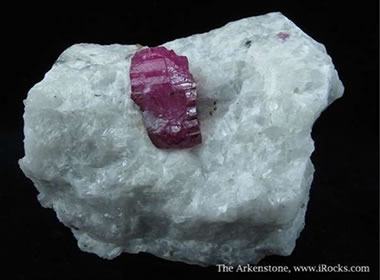
Ruby on marble: A ruby crystal on white marble from Jegdalek, Saroby, Afghanistan. This crystal is about 1.6 centimeters in length. Specimen and photo by Arkenstone / www.iRocks.com.
What Makes a Ruby?
Rubies are gem corundums with a dominant red color. The color can range from orangy red to purplish red or brownish red. The most desirable color range is a pure vibrant red to a slightly purplish red.
The red color of ruby is produced by the presence of chromium in the gem. A small trace of chromium will produce a pink color. To be considered a ruby, there must be enough chromium to give the gem a distinctly red color.
Finally, rubies must have a combination of color and clarity that makes them an attractive gem. Opaque pieces of corundum with just a hint of red color are not rubies - they are common corundum.
Physical Properties of Corundum |
|
| Chemical Classification | Oxide |
| Color | A gem corundum with a dominant red color is a ruby. Any other color of corundum is a sapphire. |
| Streak | Colorless (harder than the streak plate) |
| Luster | Adamantine to vitreous |
| Diaphaneity | Transparent to translucent |
| Cleavage | None. Corundum does display parting perpendicular to the c-axis. |
| Mohs Hardness | 9 |
| Specific Gravity | 3.9 to 4.1 (very high for a nonmetallic mineral) |
| Diagnostic Properties | Hardness, high specific gravity, six-sided crystals sometimes tapering to a pyramid, parting, luster, conchoidal fracture |
| Chemical Composition | Al2O3 |
| Crystal System | Trigonal |
| Uses | Historically used as an abrasive. Specimens with pleasing colors have a long history of gemstone use. |
Ruby Treatments
Very few specimens of corundum have a natural color within the range required for a ruby. Very few also have the clarity required to produce a nice faceted stone. Long ago, people who prepared gem materials for cutting began experimenting with ways to improve their color and clarity.
Heating
Heating corundum crystals under controlled conditions can improve or intensify their color. Heating can also remove inclusions by causing them to dissolve, making them less visible and improving the clarity of a gem.
Most rubies in the market today have been heated to improve their color and clarity. This heat treatment is normal and expected in the gem trade, but a seller should disclose the treatment to a buyer in advance of a sale.
Fracture Filling
One of the early treatments was to fill surface-reaching fractures with oils, waxes, or resins. These treatments filled pits and fractures on the surface of the gem and improved their appearance. However, these treatments are not permanent because the oils can be washed out, and the waxes and resins can crack and fall out with age - even with special care. They produce a temporary improvement in the appearance of the stone and are mainly done to produce a quick and profitable sale.
A more permanent type of fracture treatment is to fill the fractures with minor amounts of flux, glass, or another durable material. These enter the fractures during the heat treatment process. When the stone cools, a permanent filling of the fracture was accomplished. These treatments reduce the visibility of the fractures and improve the clarity of the gems. They also might improve the durability of some stones. This type of treatment is generally acceptable but should be disclosed to the buyer.
A much more aggressive treatment is to heat the gem to a very high temperature and inject glass or flux into the fractures. The temperature of this treatment can be high enough that some of the ruby melts and mixes with the fracture-filling materials. The result of this treatment is an altered stone with an improved appearance. But the stone now contains an unknown and possibly significant amount of non-ruby material. If these gems are sold “by the carat,” the buyer might pay a significant portion of the price for non-ruby material. Many people believe that these treatments produce man-made composite materials that should not be called “ruby.”
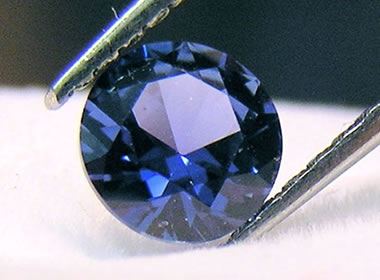
Montana sapphire: The most widely known sapphire locality in North America is Yogo Gulch, Montana, famous for producing deep blue sapphires of excellent quality. Creative Commons photo of a gem from Barnes Jewelry, Helena, Montana, by Montanabw.
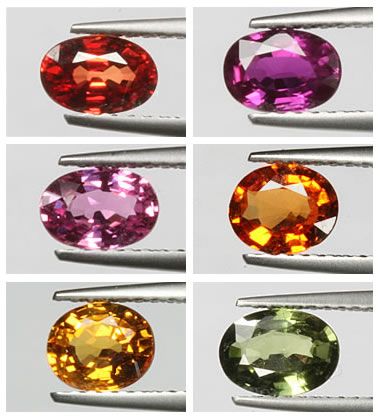
Fancy Sapphires: A collection of sapphires. Clockwise from top left: a reddish orange beryllium-heat-treated sapphire weighing 0.62 carats from Tanzania; a pinkish purple heated sapphire weighing 0.62 carats from Tanzania; a mandarin orange beryllium-heat-treated sapphire weighing 0.66 carats from Tanzania; a green heat-treated sapphire weighing 0.87 carats from Australia; an orangy yellow beryllium-heat-treated sapphire weighing 0.77 carats from Tanzania; and, a purplish pink heated sapphire weighing 0.66 carats from Madagascar. Almost all fancy sapphires have received heat or beryllium-heat treatment to improve their color.
What Makes a Sapphire?
Trace amounts of iron and titanium can produce a blue color in corundum. Blue corundums are known as "sapphires." The name "sapphire" is used for corundums that range from a very light blue to a very dark blue color. The blue can range from a greenish blue to violetish blue. Gems with a rich blue to violetish blue color are the most desirable.
Gem-quality corundum occurs in a wide range of other colors, including pink, purple, orange, yellow, and green. These gems are known as "fancy sapphires." It is surprising that a single mineral can produce gemstones of so many different colors.
When the color of a sapphire is any color other than blue, the color should be used as a preceding adjective to describe the stone. For example, pink sapphire, yellow sapphire, or green sapphire. Used alone, the word "sapphire" refers only to blue corundum.
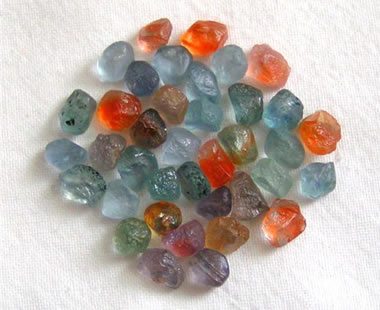
Heat-treated Sapphires: This photo shows about 49 carats of rough Montana sapphire from the El Dorado Bar that have received heat treatment. This photo is used with permission of 46 Degree Resources.
Sapphire Treatments
Just like ruby, sapphires are subjected to a wide variety of heat and fracture-filling treatments. And, just like ruby, any heat, fracture-filling or other type of treatment should be disclosed to buyers.
Spectacular Heat Treatment Results
Some rough materials that have no trace of blue color can be heated to produce a spectacular blue. Some milky to yellowish, cloudy to translucent corundum can be heated to yield stones that are transparent and bright blue. If such treatments have been used, sellers should disclose the types of treatments to potential buyers when the stone is presented for sale.
Lattice Diffusion
Some sapphires are treated by a process known as "lattice diffusion." In lattice diffusion, the sapphire is heated in the presence of a material that will release tiny metal ions. When the corundum is heated, its lattice expands enough that these tiny ions can diffuse into the gem and become trapped within the lattice when the corundum is allowed to cool. The trapped ions prevent the corundum from contracting to its normal dimensions, producing a defect that alters the color of light passing through the gem.
Beryllium diffusion can produce orange, yellow and pink colors. Titanium diffusion can produce blue. Lattice diffusion treatment is considered to be a severe treatment that is sometimes hard to detect. Some people believe that corundum which has a color produced by lattice diffusion should not be called "sapphire."
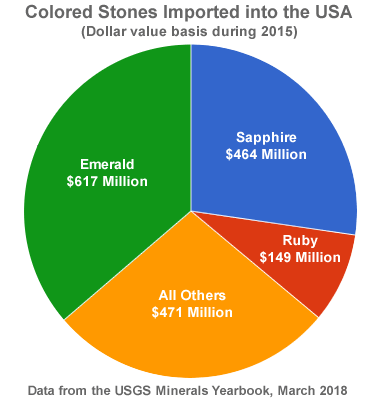
Colored stone imports: This chart illustrates the popularity of sapphire and ruby in the United States. The pie represents all colored stones imported into the United States during 2015 on the basis of dollar value. As single gem varieties, sapphire and ruby hold major positions in the import market, accounting for over 35% of all colored stones imported and a total value of approximately $613 million. Data is from the United States Geological Survey Minerals Yearbook, March 2018. [5]
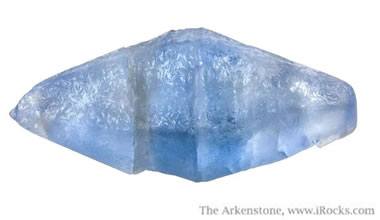
Sapphire crystal: A blue, doubly terminated, translucent sapphire crystal from Sri Lanka. Most crystal specimens like this have been transported by streams and show a greater amount of wear. This specimen has not been treated. Heat treatment would likely deepen the color, make it more uniform, and improve the clarity. This crystal is about five centimeters in length. Specimen and photo by Arkenstone / www.iRocks.com.
Popularity of Ruby and Sapphire
Ruby and sapphire are extremely popular gemstones. Virtually every jewelry store that features colored gemstones in jewelry will have a generous portion of their display dedicated to ruby and sapphire items. Ruby is the most popular red gemstone, and sapphire is the most popular blue gemstone.
The pie chart on this page shows the share of colored stone imports on a dollar-value basis that went to the categories of sapphire, ruby, emerald, and all other gemstone varieties during the 2015 calendar year. It shows that sapphire and ruby were the second and third most imported colored stones during that year. A total of $464 million worth of sapphire was imported, and a total of $149 million worth of ruby was imported.
Although the pie chart does not include domestic colored stone production, it can be considered as nearly complete. The United States Geological Survey estimates that the value of the total domestic production of colored stones of all kinds in the United States during calendar year 2015 was only $8.5 million.
Related: Emerald: The Most Popular Green Gem

Star sapphire: Some specimens of sapphire and ruby contain a very fine "silk" of fibrous inclusions that parallel the crystallographic axes of the mineral. When these stones are cut into cabochons with their c-axis penetrating their base at right angles, a six-rayed star can be seen floating on the surface of the cabochon. These are known as "star sapphires" or "star rubies," according to their color. Public domain photography by Mitchell Gore.
Mining Rubies and Sapphires
Most gem-grade corundum forms in metamorphic rocks, such as schist or gneiss; or in igneous rocks such as basalt or syenite. However, gem corundums are rarely mined from the rocks in which they form. Mining small gems from hard rock is possible, but it is very expensive, and many of the gems are broken during the mining process. Fortunately, corundum is very hard and resistant to weathering. In many areas, natural weathering and erosion have liberated the stones from their host rock, and carried them into streams over long periods of geologic time.
Today, the gems are mined from these stream sediments. Their high specific gravity relative to other sediment particles often causes currents to concentrate them in small placer deposits. Most rubies and sapphires are produced by washing the gravels of these stream deposits. This work is often done by hand because the deposits are small and irregular in shape and character. These deposits are often located in countries when wages are very low and artisanal mining is prevalent.
Noteworthy locations where gem-quality corundums have been produced include Myanmar, Thailand, Cambodia, Vietnam, India, Pakistan, Afghanistan, Sri Lanka, China, Australia, Madagascar, Kenya, Tanzania, Nigeria, and Malawi.
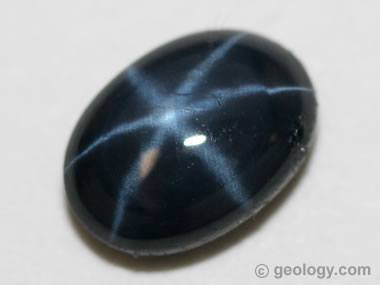
Black star sapphire: A black star sapphire 8 mm x 6 mm cabochon from Thailand. Inclusions within the stone align with the crystallographic axis to produce a six-ray silvery star. When the star is clearly visible and centered, as in this example, the base of the stone intersects the c-axis of the corundum crystal at 90 degrees. This stone has been heat treated to darken the stone and enhance the visibility of the star.
Explosion of Global Sapphire Resources
Two of the more spectacular events in the history of gemstone mining occurred when heat treatment discoveries enabled geuda (a milky white to brownish corundum, found mainly in Sri Lanka) to be converted into beautiful blue gems. Worthless corundum had suddenly become valuable! Until then the worldwide resource of blue sapphire rough was becoming more limited with each passing year. This discovery produced an instantaneous increase in the sapphire resource of Sri Lanka, and possibly similar increases in the sapphire resource in other parts of the world.
Within a short time, similar heat treatment methods were being used on a variety of smoky corundum called "dhun" that is found in Madagascar. It was easy to treat and extremely abundant, with no other competing use. This produced another increase in the world sapphire resource through the discovery of a treatment method.
Then came a treatment known as "lattice diffusion." This is a method in which corundum is heated in the presence of another material that can donate tiny atoms, such as beryllium. Heat causes the corundum lattice to expand enough that the tiny beryllium atoms can enter. When the corundum is cooled, the lattice begins to contract to its original size and shape, but the trapped atoms inside prevent that. The deformed lattice then transmits light in a different way, and the color of the corundum is changed. Beryllium diffusion can produce orange, yellow, and pink colors. Titanium diffusion can produce blue corundum.
These heat and lattice diffusion treatments have transformed worthless material and worthless deposits into valuable resources. They enabled an additional income stream from working mines, and suddenly gave previously-mined sediment in many parts of the world another chance at production. The value of this rough will not be as high as the value of rough with a natural blue color, but it will mean future jobs, future gems, and future sales.
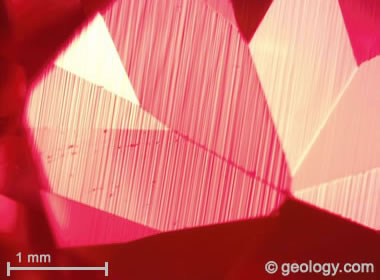
Detecting Synthetic Corundum: Examination with a microscope is the best method for detecting synthetic ruby and sapphire. When these gems are manufactured, growth features and other characteristics provide some of the strongest evidence for the synthetic manufacturing of ruby and other varieties of corundum. In the flame fusion synthesis method, growth lines develop in the crystal as the boule turns under the material feed. Near the center of the boule, these growth lines have a strong curvature. Near the outer circumference of the boule, the growth lines have a much gentler curvature. The growth lines can be difficult to see. They are only visible when viewed at a limited range of angles under certain lighting conditions. The growth lines in this synthetic ruby are very coarse. Their crossing of facet junctions confirms that they are within the stone and are not polishing lines on facet surfaces.
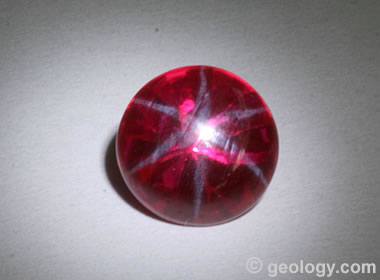
Synthetic star ruby: Laboratories have been able to mass-produce synthetic star corundum since the Lindy division of Union Carbide flooded the gem market with them in the 1950s and 1960s. This synthetic red corundum has a visible six-ray star and a faceted back to enhance the brightness of the stone.
| Ruby and Sapphire Information |
|
[1] Gems: Their Sources, Descriptions and Identification: Michael O’Donoghue; Elsevier; sixth edition; 873 pages; 2006. [2] Gemstones of the World: Walter Schumann; Sterling Publishing; fifth edition; 320 pages; 2013. [3] Rubies and Sapphires: Fred Ward; Fred Ward Gem Books; fourth edition; 65 pages; 2010. [4] Rock and Gem: Ronald L. Bonewitz; The Smithsonian Institution, Dorling Kindersley Publishing; 360 pages; 2008. [5] 2015 Minerals Yearbook - Advance Data Release: Gemstones: Donald W. Olson; The United States Geological Survey; 2018. |
Synthetic Corundum
Rubies and sapphires have been highly sought after in many parts of the world for over one thousand years. Deposits that produce high-quality stones of good color have attracted enormous amounts of attention and have been heavily exploited. As a result, buyers who need large quantities of quality stones are having a harder time finding them in the volumes needed for today's jewelry marketplace.
Let's imagine a jewelry manufacturer who wants to create enough matching ruby pendant, ring, and earring sets to supply a large jewelry chain with over 1000 stores and a busy internet site. This manufacturer will need at least four nice rubies for each matching set, multiplied by enough sets to supply over 1000 stores and a busy internet site.
This manufacturer will need hundreds of thousands, if not millions of rubies, all color-matched into sets and all cut into calibrated shapes and sizes. On the production side, the labor needed to discover, mine, grade, cut, and polish these stones will be enormous. An enormous effort will also be needed on the manufacturing side just to find enough sellers to provide them, confirm their quality, negotiate prices, make large numbers of purchases, and deliver the stones to the manufacturing facility.
Sourcing millions of natural rubies, sorted and cut to specifications will be a very difficult and time-consuming job. However, sourcing synthetic stones is a much easier and less costly job. This is why laboratories capable of reliably producing synthetic rubies and sapphires of consistent size, color, grade, and appearance have found an important place in the gemstone market.
If you go shopping in the United States and look at the ruby and sapphire jewelry offered in many famous-name mall jewelry stores and department stores in the under $100 to $500 price range, you will find that many of the jewelry items are made using "lab-created" or "lab-grown" or "synthetic" rubies and sapphires.
The synthetic corundum in this jewelry is perfect in color, has wonderful clarity and is extremely attractive. Many shoppers see the lower price and better appearance of the synthetic materials when compared to natural stones of similar size and opt to purchase the synthetic. It is a logical choice based upon what appeals to the person and what they are willing to pay. They get great appearance at a lower price.
Natural gemstones are a finite resource that will become more difficult to obtain and more expensive over time. As a result, buyers will probably see more synthetic stones offered in most jewelry stores and should expect to see the price difference between synthetic stones and natural stones of similar size, color, and quality become greater in the future.
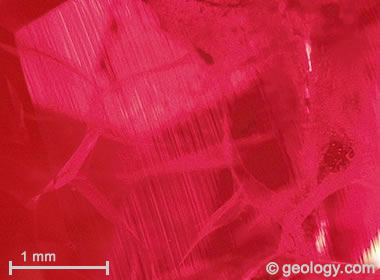
Trying to Fool Gemologists? You are looking down through a ruby that is broken by a honeycomb-shaped network of fractures. The diagonal and slightly curved striations are strong evidence that this ruby is synthetic. It is possible that this synthetic ruby was quench crackled to ruin its perfect clarity and make it look more like a natural ruby - both to the naked eye and through a microscope.
Know What You Are Buying
Synthetic rubies, sapphires and other types of gems are easy to find in the marketplace. Many stores sell them, and they account for a very significant percentage of the rubies and sapphires sold today. There is nothing wrong with selling them and nothing wrong with buying them. However, the essential part of the transaction is for the seller to clearly disclose that they are man-made and for the buyer to fully understand that they are man-made.
Sellers should make this essential communication at the time of sale by displaying synthetic gems with obvious labels, informing the customer verbally, and providing a receipt that clearly indicates that they are man-made. They might be called "man-made," "synthetic," "lab-grown," "lab-created" or some other terminology that the buyer understands.
A benefit of buying a natural ruby or a natural sapphire is knowing that your gem was created by nature. A benefit of buying a synthetic ruby or sapphire is obtaining a stone with excellent clarity and color at an affordable price. Many people have additional benefits in mind when they go shopping for jewelry.
If You Are Buying a Ruby or Sapphire...
You should know that various types of rubies and sapphires are offered for sale. Some are natural gemstones, some are natural gemstones that have been treated by people to improve their appearance, and some are synthetic gemstones created by people. Many buyers have a strong preference for untreated natural gemstones and are willing to pay a premium price for them. Others find treated gems acceptable, especially at a lower price. Some will never purchase a synthetic gemstone, but others enjoy synthetic gemstones because they generally have an attractive appearance and an attractive price.
There is nothing wrong about any of these options. It is all about personal preference and the amount that you want to spend.
The vendor who is selling these items should educate you about what you are buying in language that you understand, and information about your purchase should be written on your receipt. If you are uncertain about anything, then you should feel free to ask questions. If you have any concerns about what you are buying, then it is probably a good idea to delay the purchase or buy elsewhere. You can simply tell the vendor that "I need to think about this a little longer."
If you are purchasing a very expensive item, it is a good idea to have it identified by a gemological laboratory and receive a report from the lab. This will involve sending the item to the lab, paying a small fee, and a wait of two or three weeks to receive the lab report. Your purchase can be contingent upon the lab report being in agreement with information provided by the vendor. Even if the vendor already has a report, you can ask to have one prepared by the lab of your choice.
In summary, you should understand what you are buying, know that you have many options, and be comfortable with both the item and the price.
| More Gemstones |
 |
Birthstones |
 |
Diamond |
 |
Blue Gemstones |
 |
100+ Gems |
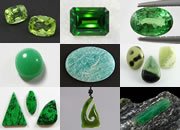 |
Green Gemstones |
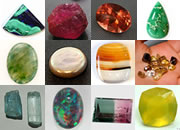 |
Mined in America |
 |
Ruby and Sapphire |
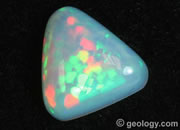 |
Ethiopian Opal |

Find Other Topics on Geology.com:

|

| ||

|

| ||

|

| ||

|

|

